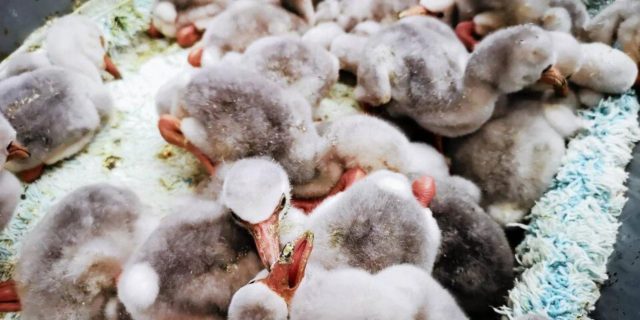“Why are the juveniles with pox virus being considered non-releasable and possibly being kept in captivity for longer than necessary?”
SEVERAL questions have been posed regarding the almost 200 juvenile flamingo chicks remaining at facilities in Gauteng.
Tania Anderson posted on the Save the Flamingo Facebook page that answers were needed to the questions being asked by people concerned about the 195 juvenile chicks.
“Why are they still covered in wax from their food and why have they not been cleaned yet? It affects their waterproofing and their bills so they won’t filter feed efficiently “
Anderson also questioned why the chicks did not have a proper large dam to bathe in and to learn to socialise in the water (like the Kimberley facility)? “These behaviours need to be learnt as early as possible to integrate into flock life.”
She asked what the physical constraints are of the 25 birds that are said to be non-releasable?
“Why are the juveniles with pox virus being considered non-releasable and possibly being kept in captivity for longer than necessary?”
According to Anderson, pox virus is a natural phenomenon in the wild population at Kamfers Dam and the chicks get it (mostly from biting insects), and develop immunity to it.
“It has been researched at Kamfers Dam already in 2010 and a scientific article was published. Some of the chicks that were rehabilitated at SANCCOB had poxvirus infections, which were the same strain as the pox virus at Kamfers Dam in 2010, according to researcher Olivia Carulei, UCT, who did the diagnosis. Therefore, the possible idea that the otherwise healthy juveniles with pox virus pose a risk to the Kamfers Dam flamingo population is unfounded. Unless it can be proven that the pox virus strain the juveniles in captivity are infected with is a different and more pathological strain.”
Anderson pointed out that the collective involved with decisions on the repatriation of the rescued juveniles were not consulted on the decision to keep the pox virus birds in captivity for research.
“Permit conditions also need to be met. Transparency and communication is lacking. We need to have all the details for future rescue protocols and to continue working together. Especially for the sake of the flamingos.”
In the comments, it is pointed out that three of the physically constrained non-releasables are partially blind.
Anderson also questioned why the late planned release of the 33 birds in March/April.
“This may cause a problem with integration with the flock as they will be a year old by then and more habituated.”
Mike Bolhuis, a private investigator who assisted with the rescue of the chicks at the dam and their rehabilitation at various bird parks, centres and zoos around the country, said in a recent report on the status of the flamingos that there were a total of 153 birds still in captivity, 95 at NZG (National Zoological Gardens) and 58 at Lory Park.
“All birds are held in PAAZA (The African Association of Zoos and Aquaria) facilities with serious medical cases being transferred to Onderstepoort, when required,” the report states.
Their possible release, according to the report, depending on the successful health examinations performed by the wildlife veterinary team will be October/November 2019 – 42/43 birds and March/April 32/33 birds.
Around 120 birds are considered non-releasable (22/25 as a result of physical constraints and 95 due to pox).
It was also noted that there are still a number of frozen carcasses at some of the ex-situ holding areas. “These need to be accounted for and the wildlife veterinary team is to decide what tests/samples need to be undertaken before incineration.”
The report further states that owing to the research value of the pox infected birds, a research project will be registered with GDARD. “Lory Park Zoo and Owl Sanctuary will be the site for the research project which will be led by the wildlife veterinary team. An educational programme will also be developed, and a version of this programme will be added to the existing, dedicated website for broader information sharing.”
A full disease risk analysis will also be undertaken by the wildlife veterinary team from Onderstepoort and NZG in conjunction with the state veterinarian, as well as full nutritional analysis on the available and required food. “In addition, the entire feeding method will be analysed, researched and improved procedures established and documented. This project will be based at Montecasino Bird Gardens.”
Thousands of small chicks were rescued from Kamfers Dam near Kimberley at the beginning of this year after being abandoned by their parents, due to low water levels.
Conservationists raised alarm bells about the situation at the dam, where newly-hatched flamingo chicks were found abandoned and exposed to extreme heat
A local community group, SaamStaan Kimberley, undertook a rescue mission at the dam and retrieved about 900 chicks. After spending the night at the Kimberley SPCA, the chicks were transported by plane to a smallholding outside Pretoria belonging Bolhuis.
Another 1 000 chicks were rescued from the dam and were moved to the SPCA in Kimberley, before being flown to Pretoria.
In total about 2 000 lesser flamingo chicks were abandoned at the dam due to falling water levels which led to easy access by dogs and other predators.
The birds were rescued and sent to zoos across the country for rehabilitation, with the aim of returning them to their home when conditions improved.
The National Zoological Gardens, National Veterinary Association, BirdLife SA, Kimberly SPCA, the Pan African Association of Zoos and Aquariums, Montecasino Bird Gardens, World of Birds, SANCCOB, Ushaka Marine World, Lory Park Animal and Owl Sanctuary and Vulpro, were part of the rescue mission.
With the Homevale Waste Water Treatment Plant, which feeds water into Kamfers Dam, being totally non-operational currently, concern has been expressed that the same situation could develop this summer as temperatures heat up and water in the dam evaporates.
The population is also threatened by a proposed massive housing development in the area.








